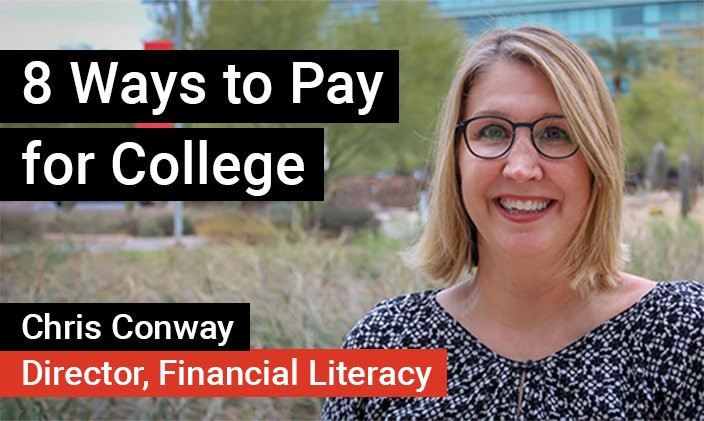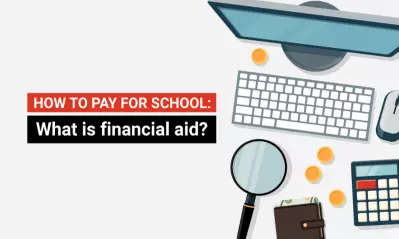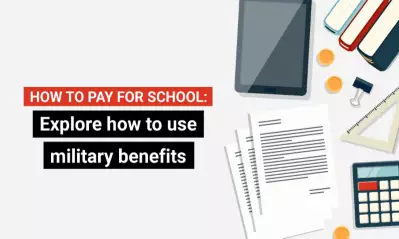8 ways to pay for college

Written by Michael Feder

Reviewed by Chris Conway, Director of Financial Education Initiatives and Repayment Management
Today’s adult learners have a variety of options to pay for college. From scholarships and loans to employer tuition benefits and transfer credits, it comes down to finding the right fit for their needs. Whether a student is upskilling as part of a current job, making a pivot in a career path or starting school for the first time, the student’s circumstances often drive the type of financial aid awards they’re eligible for.
Christine Conway, director of financial education initiatives at University of Phoenix, said there are a number of opportunities to make school more affordable and fit in with existing financial obligations. She suggests adopting a search strategy that starts with exploring scholarships and grants. Next, you should look at other lower cost options, and lastly, weigh taking on a loan.
“It sometimes takes a little time and effort to explore the options, but it is time well spent if you can reduce what you are borrowing and get that degree,” Conway said.
Conway suggests eight ways to help pay for college:
Financial aid
1. Scholarships: Scholarships are awards of financial support for education that are typically free from financial repayment obligations. Scholarships can be need-based or merit-based and are offered by a variety of sources. For example, University of Phoenix is currently offering up to $1 million in scholarship opportunities. There is a helpful guide on the UOPX website to assist on your journey to find and apply for scholarships. There is also a list of UOPX scholarships and a search tool
to find scholarships from other sources.
Tip: It takes time and effort to apply, but it may be worth it if you can chip away at your educational expenses. If it takes 10 hours of work to get a $1,000 scholarship, you’ve just paid yourself $100 per hour for your effort.
2. Federal grants: There are different types of federal grants students can qualify for when they fill out a Free Application for Federal Student Aid, FAFSA. If you continue to meet the eligibility requirements, these grants don’t have to be paid back. Federal grants are based on financial need, so some students won’t qualify. The most common is the Pell Grant, which is available for students who are working toward their first undergraduate degree.
3. Employer tuition benefits: Many employers offer a tuition benefit to employees earning a college degree, especially if it’s in an area that will directly help you in your job. There’s often a cap of $5,250 to remain within IRS guidelines.
While most employers who offer tuition benefits are large organizations, some small businesses might also be willing to provide tuition benefits. If you’re planning to go back to school, reach out to your supervisor or HR department to ask if they offer tuition help.
Tip: If you are unemployed and know you want to go back to school, consider narrowing your job search to organizations that offer tuition benefits.
4. Military benefits: Understanding your military benefits to pay for college may require some explanation from a financial aid expert. There are active-duty benefits, as well as benefits for previous military experience. The University has a helpful page
to help determine which benefits you may qualify to receive, and you can always contact the University to talk to a financial aid specialist directly.
Tip: Students who qualify for military education benefits may also be eligible for federal financial aid. To apply, you’ll need to fill out a FAFSA.
Your money
5. Cash payments from your savings or income: After you’ve exhausted the options above, the next funding source you should consider is financing your education with your own money. If you have savings to dip into or an income that can support paying tuition as you go, this will save you from paying interest on top of your tuition bill.
Lower-Cost Credits
6. Prior Learning Assessment (PLA): UOPX students can apply to have their prior learning and life experiences evaluated for college credit. These can be previous professional certificates, work training or even bereavement or raising a child. While any credit awarded is based on the individual’s submission, the PLA program can be very useful. On average, 65% of undergrad students who take advantage of the PLA program are awarded credits. Plus, the PLA program is potentially a great way to save time, as well.
Tip: Apply for PLA at the beginning of your college journey. You will have more options to knock out general education courses you need to graduate.
7. Other alternative credit options: UOPX accepts credit earned by completing courses from alternative sources, like Sophia , StraighterLine
and Study.com
. These are lower-cost, self-paced courses that can help you reduce your overall cost of college. They can also speed up the time it takes for you to earn your diploma.
Tip: Like the UOPX PLA program, consider seeking these alternative credit options when you first begin college. They may help you complete your general education requirements.
Loans
8. Federal student loans: The most common way to pay for college is also one of the most expensive. Direct subsidized and direct unsubsidized loans are not based on credit history. If you have exhausted all other options, federal loans are a better choice than taking out a personal loan.
Federal loans typically have a lower interest rate than personal loans or credit cards. Plus, there are other benefits, like deferring payments while you are in school or if you encounter financial hardship. Federal student loans also come with lots of repayment options.
Tip: You don’t have to accept the full amount of the federal loan you are offered. Only borrow the amount you need to cover your tuition, and only after you have explored your other payment options. Federal loans may be better than a personal loan, but you still have to pay back the money.
College is worth the investment
College is a big investment and financial commitment; however, when you consider the many ways to pay for college, it is doable. It may take some extra time and effort, but when students look for free money first, use their own money second, look for lower-cost options third, and consider borrowing only as a last resort, college can be more affordable.
When you consider the possible gain in earning income with a degree, the time and money it takes to get an education is worth it, Conway said. However, she said, you need to finish your program to reap the rewards.
“You’re less likely to see the return on investment if you don’t have that degree,” Conway said. “It is really important that students recognize this up front. If you are borrowing money, make sure that your goal is to graduate so that you reap the benefits of it.”
Editor’s note: As a higher learning institution, University of Phoenix recognizes that there are a diversity of viewpoints and opinions in the marketplace of ideas. This blog series provides a forum for discussion that represents that diversity of thoughts and ideas and does not necessarily represent the position of University of Phoenix, but rather advances openness and discussion of sometimes controversial topics.

ABOUT THE AUTHOR
A graduate of Johns Hopkins University and its Writing Seminars program and winner of the Stephen A. Dixon Literary Prize, Michael Feder brings an eye for detail and a passion for research to every article he writes. His academic and professional background includes experience in marketing, content development, script writing and SEO. Today, he works as a multimedia specialist at University of Phoenix where he covers a variety of topics ranging from healthcare to IT.

ABOUT THE REVIEWER
As Director of Financial Education Initiatives and Repayment Management, Chris Conway works with departments across the University to provide resources that allow students to make more informed financial decisions. She is also an adjunct faculty member for the Everyday Finance and Economics course at the University, and she chairs the National Council of Higher Education Resources College Access and Success Committee. Conway is committed to helping college students make the right financial decisions that prevent future collection activity.
This article has been vetted by University of Phoenix's editorial advisory committee.
Read more about our editorial process.
Read more articles like this:






